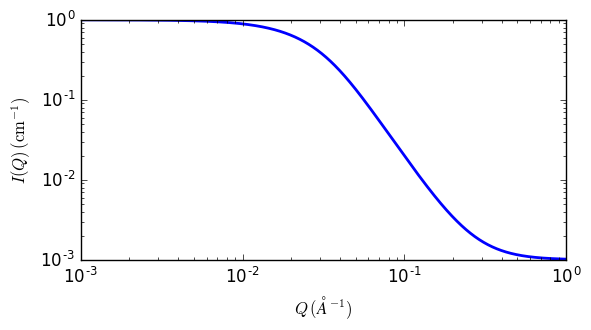polymer_excl_volume
Polymer Excluded Volume model
| Parameter | Description | Units | Default value |
|---|---|---|---|
| scale | Source intensity | None | 1 |
| background | Source background | cm-1 | 0.001 |
| rg | Radius of Gyration | Å | 60 |
| porod_exp | Porod exponent | None | 3 |
The returned value is scaled to units of cm-1 sr-1, absolute scale.
This model describes the scattering from polymer chains subject to excluded volume effects and has been used as a template for describing mass fractals.
Definition
The form factor was originally presented in the following integral form (Benoit, 1957)
where \(\nu\) is the excluded volume parameter (which is related to the Porod exponent \(m\) as \(\nu=1/m\) ), \(a\) is the statistical segment length of the polymer chain, and \(n\) is the degree of polymerization. This integral was later put into an almost analytical form as follows (Hammouda, 1993)
where \(\gamma(x,U)\) is the incomplete gamma function
and the variable \(U\) is given in terms of the scattering vector \(Q\) as
The square of the radius-of-gyration is defined as
Note that this model applies only in the mass fractal range (ie, \(5/3<=m<=3\) ) and does not apply to surface fractals ( \(3<m<=4\) ). It also does not reproduce the rigid rod limit (m=1) because it assumes chain flexibility from the outset. It may cover a portion of the semi-flexible chain range ( \(1<m<5/3\) ).
A low-Q expansion yields the Guinier form and a high-Q expansion yields the Porod form which is given by
Here \(\Gamma(x) = \gamma(x,\infty)\) is the gamma function.
The asymptotic limit is dominated by the first term
The special case when \(\nu=0.5\) (or \(m=1/\nu=2\) ) corresponds to Gaussian chains for which the form factor is given by the familiar Debye function.
For 2D data: The 2D scattering intensity is calculated in the same way as 1D, where the \(q\) vector is defined as

Fig. 99 1D plot corresponding to the default parameters of the model.
References
H Benoit, Comptes Rendus, 245 (1957) 2244-2247
B Hammouda, SANS from Homogeneous Polymer Mixtures - A Unified Overview, Advances in Polym. Sci. 106(1993) 87-133